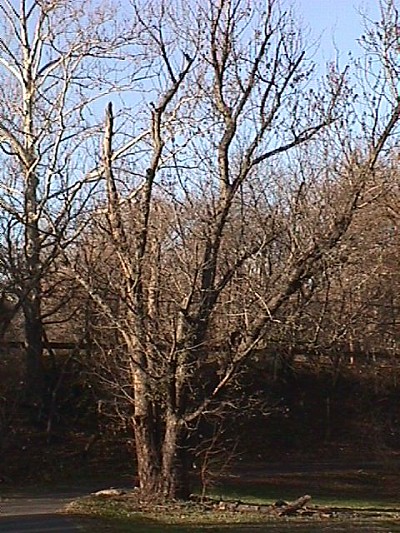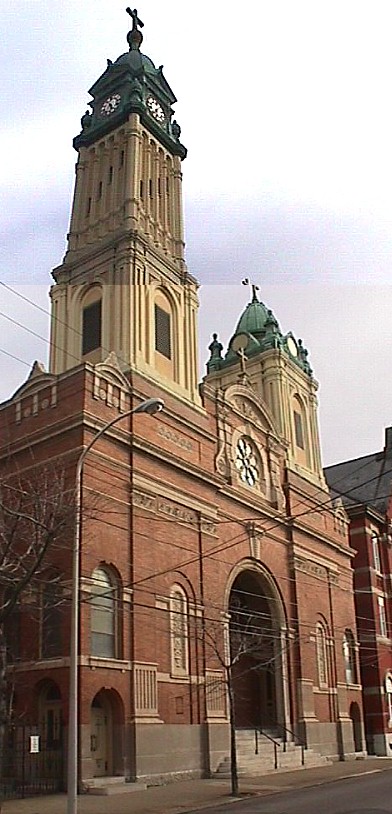2005.08.18 13:10
the agnostic design of spiritual space
I'm not sure that "certain laboratory/experimental conditions" is the same as "a matter of context that is described and framed by a particular language in preference to another" because laboratory/experimental conditions are not the same as language.
I wonder if there are certain architectural contexts where light behaves like a wave and if there are other certain architectural contexts where light behaves like a particle.
There is a picture of the sacred tree that used to be in Tacony Creek Park in A Quondam Banquet of Virtual Sachlichkeit: Part: I.
Throughout 1999 I was writing The Saintly Patronessing of Women Architects about Flavia Julia Helena Augusta, St. Helena. Earlier this year on the day most architects were thinking about the death of Philip Johnson, I and many of my friends were mourning the death of Leslie Deis. I wasn't able to attend Leslie's memorial service in Dallas, but I sent a message with my friends that did go:
It is thanks to Leslie that my fledgling CAD business, Arcadia - Architectural CAD Services, got off the ground. As a result, Arcadia came to share office space with Dekoda Architects, and it was there that I got to know and indeed love Leslie. I'll never forget the sound of her quick laugh, her red lipstick smile, and her abundant enthusiasm for all kinds of things, especially people. After I moved Arcadia back home, what I missed most were those mornings when it was just me and Leslie before Doug and Tony showed up. I realized it was really nice having Leslie's company all to myself, even if it was for less than half an hour a few times a week. Luckily, this loss of "Leslie time" was made up for when the two of us drove all the way straight through to Savannah, Georgia, in the heat of the night, and we talked, and talked, and talked the whole way.
The last time I saw Leslie it was again just me and her. She had come to my house to collect the forgotten materials relative to art projects she had commissioned, but which never came to full fruition. We were both surprised at how much of "her" was stored within the flatfiles of my basement. Finally, all this stuff, especially the pictures of her with Rose and with Gus were going to be where they were supposed to be.
Before Leslie left, I asked if she would like to visit a sacred tree in nearby Tacony Creek Park. She said, "Sure." Since the 1990s Tacony Creek Park has become the site of what one might call your more ancient religious rituals, and it had been reported that charms and amulets were occasionally found around a rare quintuplet tree in the park. When at the tree, both Leslie and I admitted to not feeling anything special, but we admired the tree nonetheless.
A couple weeks later, I was reading about St. Barbara, the patron saint of architects, whose feast day is December 4th. Unfortunately, St. Barbara is one of those saints that most likely never really existed. There may not have been a St. Barbara, but I know there are others out there that are very much like what one might call a patron saint of architects. I was actually with such a person on December 4th 2000, and we spent some time that day looking at a sacred tree.

Sacred Tree Tacony Creek Park, Philadelphia 2000.12.04
| |
2005.08.18 13:36
sacred or profane
Is Madonna falling off a horse sacred or profane?
18 August
Happy circa 2750th Anniversary of the Rape of the Sabine Women!
Did you know that the tradition of a groom carrying his bride over the threshold is a reenactment of the rape of the Sabine women?
2005.08.18 15:49
Why do you think you're creative?
Well, we all operate metabolically, that's for sure. And the operation of fertility is definitely part of our design. That leaves, for sure, assimilation, electromagnetism, osmosis, and then all high frequencies.
They say metabolism is in every cell. That might be true for every living human cell, and even if it's only almost every living human cell that has metabolism in it, imagine then a destructive-creative duality going on in nearly all the cells of your body the whole time you're alive. (This exercise is actually an experiment in first stimulating the assimilating imagination.)
2005.08.18 18:39
Why do you think you're creative?
Well, the two most prodominant modes of imagination under which humanity presently operates are the assimilating imagination and the metabolic imagination. It will remain that way for almost 200 more years. Then like at least a half century of predominantly the metabolic imagination in operation.
2005.08.20 10:24
Tiring architects VS Real Architects
I suppose you're referring to Gehry, who was originally Frank O. Goldberg. Maybe architects should change their name every time they design a new and different-than-the-last building. Maybe my next architecture will be by Dick Hertz.
2005.08.20 10:46
Why do you think you're creative?
I actually spent a lot of yesterday at several locations in North Philadelphia. The place is vast. As far as I'm concerned, the place never stopped being glorious.
I was inside St. Michael's Catholic Church for the first time yesterday. It's on 2nd Street around Thompson (i.e., a couple blocks north of Girard Avenue. That place has a glory to it inside and out.
I will not participate in the ideas competition. I'll just continue to often visit North Philadelphia as an architectural tourist.
2005.08.21 16:26
Why do you think you're creative?
I like all the direct answers so far, yet I didn't expect so many to indirectly answer that they think they're creative because of what some other people think creativity is--that's more like being un-creative, isn't it?
I especially like the notion of "I think I'm creative because I'm sinister" because it demonstrates that acting creatively is not always manifest within a morally "correct" context.
2005.08.22 16:09
Re: WHY IS MODERN ART LOOKING SO UN-MODERN? Unbekannt
Happy Birthday Leni Riefenstahl!
2005.08.22 16:36
Thesis Topics
If you're interested in art and museum architecture, a new Barnes Foundation on the Benjamin Franklin Parkway would be a great thesis building design project. The art deserves a lot more space, as do the visitors. Of course, the Barnes Foundation is (ridiculously) restricted into keeping the art arranged as if still in the old/existing facility, but if that restriction were not in place (which is the thesis project I'm suggesting) the architectural possibilities are enormous. The site along the Benjamin Franklin Parkway is also a challange, but well worth attempting.
| |

Edwin Forrest Durand St. Michael's Catholic Church 1846-47 Philadelphia, PA 2000.11.11
|